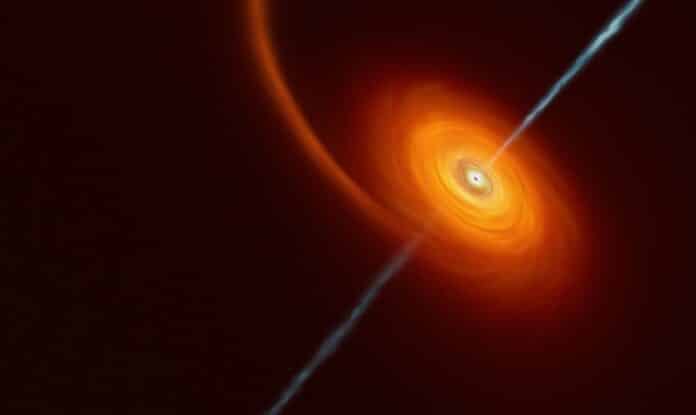Earlier this year, the European Southern Observatory’s Very Large Telescope (ESO’s VLT) was alerted after an unusual source of visible light had been detected by a survey telescope. The VLT, together with other telescopes, was swiftly repositioned towards the source: a supermassive black hole in a distant galaxy that had devoured a star, expelling the leftovers in a jet. The VLT determined it to be the furthest example of such an event to have ever been observed. Because the jet is pointing almost towards us, this is also the first time it has been discovered with visible light, providing a new way of detecting these extreme events.
Stars that wander too close to a black hole are ripped apart by the incredible tidal forces of the black hole in what is known as a tidal disruption event (TDE). Approximately 1% of these cause jets of plasma and radiation to be ejected from the poles of the rotating black hole. In 1971, the black hole pioneer John Wheeler introduced the concept of jetted-TDEs as “a tube of toothpaste gripped tight about its middle,” causing the system to “squirt matter out of both ends.”
“We have only seen a handful of these jetted-TDEs and they remain very exotic and poorly understood events,” says Nial Tanvir from the University of Leicester in the UK, who led the observations to determine the object’s distance with the VLT. Astronomers are thus constantly hunting for these extreme events to understand how the jets are actually created and why such a small fraction of TDEs produce them.
As part of this quest many telescopes, including the Zwicky Transient Facility (ZTF) in the US, repeatedly survey the sky for signs of short-lived, often extreme, events that could then be studied in much greater detail by telescopes such as ESO’s VLT in Chile. “We developed an open-source data pipeline to store and mine important information from the ZTF survey and alert us about atypical events in real time,” explains Igor Andreoni, an astronomer at the University of Maryland in the US who co-led the paper published today in Nature together with Michael Coughlin from the University of Minnesota.
In February of this year the ZTF detected a new source of visible light. The event, named AT2022cmc, was reminiscent of a gamma ray burst — the most powerful source of light in the Universe. The prospect of witnessing this rare phenomenon prompted astronomers to trigger several telescopes from across the globe to observe the mystery source in more detail. This included ESO’s VLT, which quickly observed this new event with the X-shooter instrument. The VLT data placed the source at an unprecedented distance for these events: the light produced from AT2022cmc began its journey when the universe was about one third of its current age.
A wide variety of light, from high energy gamma rays to radio waves, was collected by 21 telescopes around the world. The team compared these data with different kinds of known events, from collapsing stars to kilonovae. But the only scenario that matched the data was a rare jetted-TDE pointing towards us. Giorgos Leloudas, an astronomer at DTU Space in Denmark and co-author of this study, explains that “because the relativistic jet is pointing at us, it makes the event much brighter than it would otherwise appear, and visible over a broader span of the electromagnetic spectrum.”
The VLT distance measurement found AT2022cmc to be the most distant TDE to have ever been discovered, but this is not the only record-breaking aspect of this object. “Until now, the small number of jetted-TDEs that are known were initially detected using high energy gamma-ray and X-ray telescopes, but this was the first discovery of one during an optical survey,” says Daniel Perley, an astronomer at Liverpool John Moores University in the UK and co-author of the study. This demonstrates a new way of detecting jetted-TDEs, allowing further study of these rare events and probing of the extreme environments surrounding black holes.
Journal Reference
- Igor Andreoni, et al. A very luminous jet from the disruption of a star by a massive black hole. Nature DOI: 10.1038/s41586-022-05465-8
